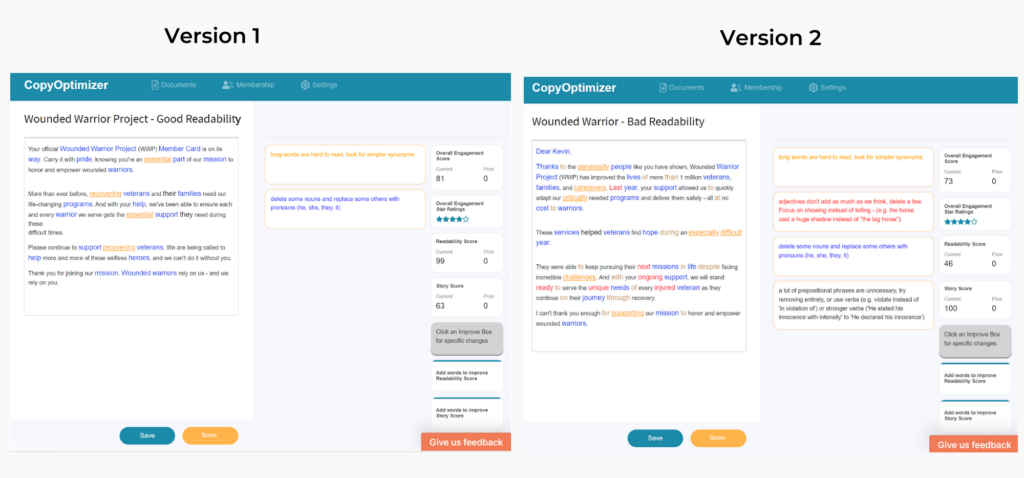What makes for good copywriting?
As non-profits, we understand that our copy has to be engaging and compelling enough to urge people to donate to our cause. While there isn’t an all-encompassing formula giving us everything we need to know about writing “good copy,” we have an idea of what works and doesn’t work to produce the best results.
Through rigorous testing, we have found some of those key elements and put them to the test by using a tool created by DonorVoice called the Copy Optimizer*. With this tool, we analyzed 80 organizations across 8 verticals, and examined 2000 emails.
This tool uses algorithms to measure how personal the copy sounds (readability) and how much it reads like a story (storytelling).
On average, nonprofit emails scored a 50 out of 100 for readability.
That’s not horrible, but it leaves a lot of room for improvement. That should be good news for you because that means there’s opportunity to grow!
What does it mean for your copy to be readable?
If in the experiment below, we found that the emails that produce the best results (clicks and donations) are those that sound like real people wrote them.

Version 2 called the reader by name, used conversational language, and use a friendly and human tone. By doing so, it led to a 46% increase in people donating!
Because in the end, people give to people!
In theory, writing copy to sound more conversational and natural may sound easy, maybe even common sense to some. But in practice, we sometimes start to overthink our tone and delivery. As a result, our message gets buried under complicated jargon.
The Copy Optimizer tool from Donor Voice measures readability by looking for the following:
4 Items that reduce readability of your copywriting
- Nouns. The fix is replacing nouns with pronouns (e.g., he, she, they, it)
- Long words that are difficult to read
- Adjectives that don’t add much to the message. Focus on showing instead of telling
- Prepositional phrases are usually unnecessary. Try removing these entirely or use verbs (e.g., violate instead of ‘in violation of’) or stronger verbs (‘He stated his innocence with intensity’ to ‘He declared his innocence’)
10 items that increase the readability of your copywriting
- To increase the intensity, use words like really, very, extremely, highly, intensely, strongly, perfectly, totally, utterly, etc.
- Where nouns that have already been mentioned refer to them with words like those, this, or these
- Make your copy feel more like a natural conversation by using well, now, anyhow, anyways
- Add conversational emphasis to your writing with “just, really, most, more, for sure, a lot, such as”
- Use we and our to bring the reader in; use I or me to share details about the writer
- Instead of nouns, refer to people or things by using anyone, anything, nobody, none, etc.
- Replace the noun with “it”
- Use versions of ‘you,’ but you don’t need to use more than other pronouns
- Use contractions to make your writing more conversational and personal, e.g., it’s for it is, she’s for she is, etc.
- Share the thoughts and feelings of the writer using a first-person pronoun (I or we) and these verbs – hope, believe, want, need, suspect, imagine, dream, fear, think, realize, discover
An Example of Improving Copy Readability
Let’s take a look at a couple of examples using the Copy Optimizer.

The example below is from the same organization. They both scored high on overall engagement scores, but the one on the left scored higher in readability.
Based on algorithms from the Copy Optimizer, here are some key takeaways from the emails above:
1. The Copy Optimizer app is only going to flag your copy for long words if your average word length is longer than what we find in personal letters and conversations. “Fancy” words with lots of syllables might sound impressive but they require more effort to read and aren’t the way we talk to folks we know.
2. Adjectives don’t add as much as we think. They tend to add clutter and are often lots of telling instead of showing. The big horse isn’t nearly as vivid and interesting as “the horse cast a huge shadow”.
3. Prepositions are often unnecessary. This won’t seem obvious at first but now that you’re sensitized to it, you’ll likely find that you can change many of your prepositions to verbs or just delete them altogether. For example, instead of “she went to the store” make it “she went shopping”. That “ing” of words is key.
Improving Readability can Lead to Greater Giving
Let’s look at an experiment that clearly demonstrates the power of readability to improve clarity and increase donations.

The organization on the previous page wanted to test whether or not simplifying the contents of the open letter (by decreasing the evaluated “reading grade level” from 10th-grade down to a 6th-grade reading level) would impact letter signature rates, donor conversion, or revenue.
What we concluded from this experiment is that by lowering the reading level of the message, we observed a 90.8% increase in revenue for open letter signers who became donors on the subsequent instant donation page.
Lowering the reading level increased the readability of the letter to lawmakers. The theory is that this increased “directness” of the message better represented the reader/signer’s message. When presented with an ask, they gave more generously on the instant donation page.
Find Other Ways to Improve Your Copywriting
There’s no all-encompassing secret formula for copywriting. However, through A/B testing and experimentation, we have discovered some fundamental principles about what works – and doesn’t work – to write more effective copy.
In this new research report in partnership with DonorVoice, we analyzed 2,000 emails from 80 organizations to discover new ways for you to improve your own nonprofit copywriting.
Learn more and get a free copy of the nonprofit copywriting report »




